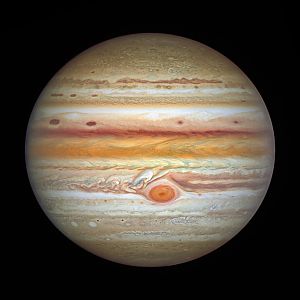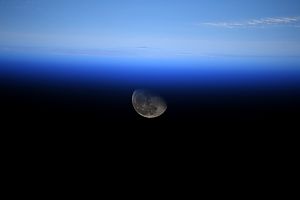Space Year 2022 - After Mars, now the Moon, Jupiter and asteroids
Numerous missions are heading for the moon and want to prepare for the return of manned space flights to the Earth's satellite. ESA finally wants to launch its new launcher "Ariane 6" and is setting off for Jupiter. In addition, spectacular missions to asteroids will be launched or will already find their destination there in 2022.

With the "Artemis" programme, the US space agency NASA wants to pick up where it left off with the "Apollo" programme. This does not only include putting men on the moon again. In order to create a basis for future Mars flights, a space station is also to be brought into lunar orbit and a station is to be built on the moon itself, as Anneliese Haika from the Vienna Working Group for Astronomy (WAA) recently explained at a lecture.
An important step in this direction is the first major test of the "Orion" space capsule as part of the "Artemis 1" mission. Still without humans on board, "Orion" and its service module from the European Space Agency (ESA) are scheduled to launch on 12 February in the direction of the Moon, orbit it for about a week and then return to Earth for a landing.
Experiments on the moon
Within the framework of the "Artemis" programme, various experiments will also be brought to the lunar surface. The first ones will be delivered in 2022 by the two private companies "Intuitive Machines" and "Astrobotic" as part of the "NASA Commercial Lunar Payload Services". The spectrum ranges from photovoltaic studies on the moon to the measurement of volatile substances or neutron radiation to autonomous navigation. All this is intended to "pave the way for the first woman and the next man to reach the moon", according to NASA. Incidentally, NASA has awarded Nokia the contract for the construction of a mobile phone network on the moon, which the technology company wants to set up from the end of 2022.
The space company SpaceX, owned by US billionaire Elon Musk, wants to launch its "Starship" spacecraft, designed for lunar landings, at the beginning of next year. It should then be ready for its first transport flights into space in 2023. NASA is currently planning to use "Starship" as a landing module in the "Artemis" programme in 2025 at the earliest. At Boing, a test flight of the crisis-ridden "Starliner" spacecraft, which is to transport astronauts to the International Space Station (ISS) in future, is scheduled for May at the earliest.

Race to the moon
The fact that history repeats itself is also evident in the new race between the USA and Russia to the moon. The "Luna 25" mission planned by Russia and the ESA is scheduled to launch in July and land near the moon's south pole - the first Russian lunar landing since "Luna 24" in 1976. The goals are to test landing technology, search for ice and prepare further missions.
But other countries are also involved in this race to the Earth's satellite: South Korea is planning its first moon mission next year. The "Korea Pathfinder Lunar Orbiter" is scheduled to launch in August and orbit the moon for a year.
After India's lunar probe "Chandrayaan 2" crashed on the lunar surface in 2019 due to a software error, the country is planning a new attempt in the second half of 2022. "Chandrayaan 3" will use the lunar orbiter that was launched with "Chandrayaan 2" in 2019 and has been orbiting the Earth's satellite ever since. Japan also plans to launch its "Smart Lander for Investigation Moon" (SLIM) and land it on the moon in 2022 at the earliest. SLIM is to take off together with the X-ray telescope XRISM, with which Japan wants to investigate hot plasma in various environments, such as plasma streams around black holes.
Mars is not quite finished yet either: after problems with the parachutes, the Russian-European mission "Exo-Mars" is now scheduled to launch in September 2022 and land on Mars in June 2023. The "Rosalind Franklin" rover will then search for traces of past life on the Red Planet. If everything goes well, the rover will be the first time that technology from Austria will land on Mars: The Viennese space company RUAG Space built the more than one-metre-long fold-out camera mast made of carbon fibre for the "eyes" of the Mars vehicle and produced the electronics for the power supply for the rover's computer.
Jupiter and its moons
Apart from this mission, which has been accompanied by many failures and delays, 2022 will be an exciting year for ESA: it is setting its sights on Jupiter and its moons and intends to finally launch its new launch vehicle.
ESA's JUICE (Jupiter Icy Moons Explorer) mission focuses on exploring the Jupiter system. It is scheduled to launch in June 2022 and arrive at the gas giant in 2029. The probe, in which the Institute of Space Research (IWF) of the Austrian Academy of Sciences (ÖAW), Graz University of Technology and RUAG Space are also involved, aims to explore the interaction of Jupiter and its large moons.
The maiden flight of the new European launcher "Ariane 6" was already planned for 2020, but after massive delays, ESA is now aiming for the first launch of the rocket built by ArianeGroup in 2022. Some of the components will come from Austria, such as the high-temperature insulation for the rocket engines made of glass and ceramics from RUAG Space, the data transmission protocol from TTTech and valves from Test Fuchs. In addition, a new, more powerful version of the Vega rocket (Vega-C) is due to take off for the first time in May, with an igniter housing from the Upper Austrian company Peak Technology.
In autumn 2022, ESA plans to announce the decision for the next European astronauts. More than 23,000 people have submitted applications for the job, 464 of them from Austria. They now have to go through a six-stage selection process. They are looking for four to six permanent astronauts and up to 20 reservists.
Protection from asteroids
Not only the very large objects of the solar system will be the focus of interest in 2022, but also the very small ones: a few weeks ago, NASA launched the DART (Double Asteroid Redirection Test) mission, which is to hit the asteroid Dimorphos - literally - in October 2022. The plan is to let the probe crash into Dimorphos, which is about 160 metres in diameter and a kind of moon of the asteroid Didymos, thereby changing its trajectory. It is hoped that this will provide insights into how the Earth could be protected from approaching asteroids.
In addition, NASA is planning the first mission to a metal-rich asteroid, "Psyche", in 2022. The launch is planned for August, the arrival at the approximately 226 kilometre large asteroid "16/Psyche" is scheduled for 2026. The probe is to orbit the possible former planetary nucleus for one year. The mission has a twin probe as a passenger: The two mini probes of the "Janus" mission are to investigate two different double asteroids in 2026 and, with "Psyche", provide insights into the formation and development of small boulder asteroids.
China continues to expand its sky palace
China is currently concentrating its space activities on the expansion of its space station "Tiangong" ("Heavenly Palace"). The Chinese space agency is planning a total of eleven missions to the station by the end of 2022, including the launch of two new laboratory units to expand the station into orbit. The "Heavenly Palace", where astronauts already live and work, is to be fully operational next year.
China is also planning to launch "Macao Science 1" in December. It will be the first satellite to explore the geomagnetic field and, in particular, the South Atlantic Anomaly from space from an orbit close to the equator. The centre of this zone with a significantly weakened geomagnetic field and thus increased radiation activity lies off the coast of Brazil. Sensors and components from the IMF and Graz University of Technology are coming from Austria.
The "James Webb" telescope, which was successfully launched on 25 December, is expected to deliver the first observation data in mid-2022. At that time, the launch of another space telescope is planned: ESA's "Euclid" probe will measure the redshift and shape of galaxies and galaxy clusters in a very large area of the sky with a 1.2-metre visible and near-infrared mirror about 1.5 million kilometres from Earth. The aim is to better understand the distribution of dark matter in the universe and its expansion. It may also allow conclusions to be drawn about the mysterious dark energy.
But you don't necessarily need rockets to explore space with a telescope: In June 2022, the Max Planck Society wants to use a helium-filled balloon to bring the largest solar telescope ever to leave the earth, with a diameter of one metre, to an altitude of 35 to 37 kilometres with the "Sunrise 3" mission. There, the two-ton telescope will drift along the Arctic Circle for several days before landing again by parachute. Such flights with a balloon-borne solar observatory were already successful in 2009 and 2013. The mission aims to gain insights into the altitude stratification of the solar atmosphere from the photosphere to the chromosphere. The ESA/NASA "Solar Orbiter" probe launched in 2020 will come much closer to the sun in March 2022 - at 50 million kilometres, closer than any space probe ever before - and provide new images of our central star.
